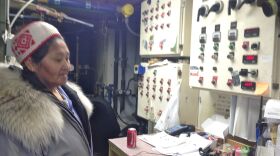April 28, 2015
Most of us have never lived with without running water at home. Today, we’ll learn about some people who are just getting used to it, and others who would like to get used to having running water. In the second segment of the series Kick the Bucket, we’ll also hear some of the reasons Alaska hasn’t made modern plumbing a simple fact of life for all Alaskans.
Dan Winkleman, the president of the Yukon Kuskokwim Health Corporation (YKHC), described a recent phone call from his mother-in-law in Kwethluk.
“She said, ‘Guess what?’ 'So I said, 'What?’ She said, ‘I just finished doing the dishes in my sink with the water from the faucet and I wanted to let you know how exciting that was.’ She was giddy with excitement,” said Winkelman.
What’s so exciting about washing dishes? Kwethluk never had running water before. It wasn't easy and it wasn’t cheap: a water treatment plant, water tank and sewage lagoon cost $41 million.
That's a lot of money -- but this is rural Alaska. Weather can wreak havoc with schedules. Getting anything here is expensive, especially heavy equipment. And, piped water and sewer means digging trenches for pipes and pumps, plus installing plumbing in individual homes. But Kwethluk’s system is costly even for rural Alaska, where piped water and sewer in some communities cost in the three-to-five million dollar range.
YKHC Remote Maintenance Worker Bob White said the Kwethluk treatment plant, which cost $4.2 million, has sophisticated features to reduce maintenance and operations, such as computerized controls and sensors that will send out alerts if something isn't working as it should. And to avoid the expense of large underground sewage pipes, each home is getting a grinder pump that will move sewage through narrow, 2-inch-pipes.
Hefting the pump on to a piece of plywood, White said, “They're expensive, and they're heavy. This one's brand new.”
And it's heavy duty.
“Part of the problem, it wouldn't take the harsh conditions,” said White. “The pump manufacturer actually started making an Arctic version, and this is their Arctic version.”
Driving the half mile from the treatment plant to the sewage lagoon, White said workers dredged a pond 20 feet deep to get the soil used to build the berm around the lagoon. Raw sewage is pumped in, then natural processes take over and break it down. The Kwethluk sewer lagoon cost $7.5 million dollars – but, as White explains, that cost is all up-front.
“The good thing about a lagoon is once you construct it, your costs are pretty much done. The maintenance on this lagoon will be less than $5,000 a year,” said White. “So lagoons are really efficient if you have the land mass.”
Federal and state funding for the Kwethluk project came in increments so construction spanned some 15 years – which also added to the cost.
Fifty miles down the Kuskokwim River, Tuntutuliak, population 400, doesn't have running water and gets by on what's called a flush-haul system. Waste from flush toilets goes into a holding tank, then gets hauled away. People have to haul water. Brian Lefferts, director of YKHC's office of environmental health and engineering, said there's a public health cost to that.
“In situations like that,” says Lefferts, “we find that people drastically conserve the water and then they don't realize the health benefits that come with having piped running water and sewer service.”
Lefferts said the decision on which communities get funding for water and sewer projects comes out of a detailed evaluation.
“All the water and sewer, what we call needs in the state, get entered into a database. It's called a sanitation deficiency system,” said Lefferts. “We have estimated project costs, the number of homes they'd serve, looking at health impact, capital cost, d the current level of service, and then the level of service they'd have after the project.”
Other criteria include how well the community is doing managing what it has – collecting fees, for instance, and getting employees trained and certified.
A 1994 report by the federal Office of Technology Assessment recommended an annual budget of $120 million for rural sanitation in Alaska. Federal and state funding combined never reached that level, and now officials say it will take $900 million to catch up. That's on top of $2.2 billion dollars spent over the past two decades.
In a recent presentation to state legislators, Alaska Native Tribal Health Consortium Sanitation Facilities Program Manager David Bevridge said most of that money has come from federal agencies.
“If you look through the Village Safe Water program, it gets matched with federal dollars on a 25-75 percent ratio,” Bevridge explained. “So for every 25 dollars the federal government will kick in 75 dollars so that's been a big component of the funding in Alaska.”
In 2014, the state legislature allocated $7.5 million for Village Safe Water, out of a $13 billion state budget, to match $50 million from the Indian Health Service, Environmental Protection Agency, and U.S. Department of Agriculture. But federal funding has dropped by 64 percent in the last ten years. The gap between what's needed and what’s available is getting wider. And the lack of money for maintenance and operations right now is damaging existing systems. We'll find out more about that next time.
(5/1/2015 corrected to show Tuntutuliak is down river from Kwethluk, not upriver). # # #
This project was made possible with the support of: Annenberg School for Communications and Journalism, University of Southern California; the Dennis A. Hunt Fund for Health Journalism; RAVN Airlines, Alaska Native Tribal Health Consortium, Sonosky, Chambers, Sachse, Miller & Munson, and KYUK-FM in Bethel, Alaska. A special thanks goes to KYUK's Charles Enoch, field producer for interviews in Bethel, Kwethluk, and Tuntutuliak.







